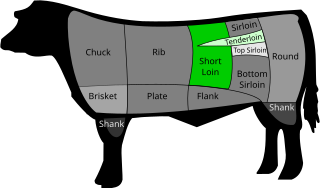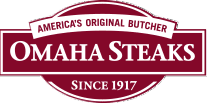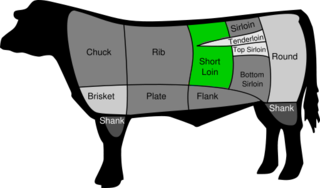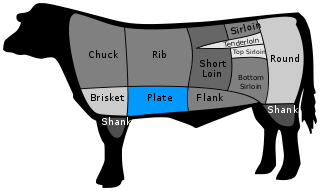Related Research Articles

A beefsteak, often called just steak, is a flat cut of beef with parallel faces, usually cut perpendicular to the muscle fibers. In common restaurant service a single serving will have a raw mass ranging from 120 to 600 grams. Beef steaks are usually grilled, pan fried, or broiled. The more tender cuts from the loin and rib are cooked quickly, using dry heat, and served whole. Less tender cuts from the chuck or round are cooked with moist heat or are mechanically tenderized.

The T-bone and porterhouse are steaks of beef cut from the short loin. Both steaks include a "T"-shaped lumbar vertebra with sections of abdominal internal oblique muscle on each side. Porterhouse steaks are cut from the rear end of the short loin and thus include more tenderloin steak, along with a large strip steak. T-bone steaks are cut closer to the front, and contain a smaller section of tenderloin. The smaller portion of a T-bone, when sold alone, is known as a filet mignon, especially if cut from the small forward end of the tenderloin.

A fajita in Tex-Mex is any grilled meat that is usually served as a taco on a flour or corn tortilla. The term originally referred to skirt steak, the cut of beef first used in the dish. Popular meats used include chicken and other cuts of beef, as well as vegetables instead of meat. In restaurants, the meat is usually cooked with onions and bell peppers. Popular condiments include shredded lettuce, sour cream, guacamole, salsa, pico de gallo, shredded cheese, refried beans, and diced tomatoes. Arrachera is a northern Mexican variant of the dish.

A beef tenderloin, known as an eye fillet in Australasia, filet in France, Filet Mignon in Brazil, and fillet in the United Kingdom and South Africa, is cut from the loin of beef.

Omaha Steaks International, Inc., known as Omaha Steaks, is a retailer of steaks, seafood, and food gifts. The company is named after the city it was founded in, and its headquarters location, Omaha, Nebraska.

The rib eye or ribeye is a beefsteak from the rib section. The rib section of beef spans from ribs six through twelve. Ribeye steaks are mostly composed of the longissimus dorsi muscle but also contain the complexus and spinalis muscles.

Flat iron steak (US), butlers' steak (UK), feather blade steak (UK) or oyster blade steak is a cut of steak cut with the grain from the chuck, or shoulder of the animal. This produces a flavorful cut that is a bit tough because it contains a gristly fascia membrane unless removed. Some restaurants offer it on their menu, often at lower price than the more popular rib-eye and strip steaks of the same grade. This is used, in some places, as a means of selling a less expensive cut from the same animal, for example Kobe beef.

The strip steak is a cut of beef steaks from the short loin from a cow. It consists of a muscle that does little work, the longissimus, making the meat particularly tender, although not as tender as the nearby psoas major or tenderloin. Unlike the tenderloin, the longissimus is a sizable muscle, allowing it to be cut into larger portions.

Skirt steak is a cut of beef steak from the plate. It is long, flat, and prized for its flavor rather than tenderness. It is not to be confused with flank steak, a generally similar adjacent cut nearer the animal's rear quarter.

London broil is a beef dish made by broiling marinated beef, then cutting it across the grain into thin strips. Despite its name, the dish and the terminology are North American, not British.

A hanger steak, also known as butcher's steak or hanging tenderloin, is a cut of beef steak prized for its flavor. This cut is taken from the plate, which is the upper belly of the animal. In the past it was sometimes known as "butcher's steak", because butchers would often keep it for themselves rather than offer it for sale. This is because the general populace believed this to be a crude cut of meat, although it is actually one of the most tender.

Chuck steak is a cut of beef and is part of the sub-prime cut known as the chuck.

The tri-tip is a triangular cut of beef from the bottom sirloin subprimal cut, consisting of the tensor fasciae latae muscle. Untrimmed, the tri-tip weighs around 5 pounds. In the U.S., the tri-tip is taken from NAMP cut 185C.

Marbled meat is meat, especially red meat, that contains various amounts of intramuscular fat, giving it an appearance similar to marble.

Short ribs are a cut of beef taken from the brisket, chuck, plate, or rib areas of beef cattle. They consist of a short portion of the rib bone, which is overlain by meat which varies in thickness. There are two major types of cuts: The "flanken", which is cut across the bone and leaves the bone just 1 to 2 inches in length, and the "English", which is cut parallel to the bone and leaves the bone up to 6 inches (15 cm) in length. English cut short ribs may be served individually, or three or four may served connected to one another. Short ribs are popular in many international cuisines.

The Ranch steak comes from the chuck cut of a cow, namely the shoulder. Technically it is called a "boneless chuck shoulder center cut steak", but supermarkets usually use the shorter and more memorable term: "Ranch steak". A ranch steak is usually cut no thicker than one inch, weighs 10 ounces or less, and is usually trimmed of all excess fat.

The beef clod or shoulder clod is one of the least expensive cuts of beef and is taken from the shoulder (chuck) region of the animal. Beef clod is a large muscle system, with some fat that covers the muscles. The clod's composition is mainly three muscles: the shoulder tender, the top blade and the clod heart and is one of two chuck subprimal cuts. It is often divided into its three separate muscle cuts for retail sale.

A steak is a meat generally sliced across the muscle fibers, potentially including a bone. It is normally grilled, though can also be pan-fried. It is often grilled in an attempt to replicate the flavor of steak cooked over the glowing coals of an open fire. Steak can also be cooked in sauce, such as in steak and kidney pie, or minced and formed into patties, such as hamburgers.

A fish steak, alternatively known as a fish cutlet, is a cut of fish which is cut perpendicular to the spine and can either include the bones or be boneless. Fish steaks can be contrasted with fish fillets, which are cut parallel to either side of the spine and do not include the larger bones. In contrast to other vertebrate animals, over 85% of the fish body is made up of consumable muscle.
Giacomo "Jack" Ubaldi was an Italian-American butcher and chef. Ubaldi is credited for the selection, marketing and sale of bottom sirloin subprimal cuts in New York City as the "Newport steak."
References
- 1 2 Strassburger 2013, p. 45.
- 1 2 3 4 5 6 7 Yue, Lorene (11 June 2012). "She's a Cut Above the Others" . Crain's Chicago Business. 35 (24) – via EBSCOhost.
- ↑ Strassburger 2013, p. 40.
- ↑ Schultz 2017, p. 8-9.
- 1 2 Slade, Rachel (31 October 2016). "The male-dominated meat industry is in need of skilled labor. Why not women? - The Boston Globe". Boston Globe. Retrieved 2020-11-28.
- ↑ Inge, Leoneda (8 December 2014). "Women butchers are slicing through the meat world's glass ceiling". MPR News. Retrieved 2020-11-28.
- 1 2 "The Art of Beef Cutting" . Food Management. 46 (11): 39. 2011 – via EBSCOhost.
- ↑ Schultz 2017, p. 7.
- ↑ Jackson, Cheryl V. (1 July 2015). "Muscolo Meat Academy wants to feed growing demand for butchers". Chicago Tribune. Retrieved 2020-11-28.
- ↑ Gough, Cherie (2019-07-29). "These 6 Women Are Breaking Barriers In The Meat Industry". HuffPost. Retrieved 2020-11-28.
Sources
- Schultz, Kevin (2017). "Pork Quality Relates Back to Knowledge" . National Hog Farmer. 6 (6): 6–10 – via EBSCOhost.
- Strassburger, Suzanne (2013). "Cut From Her Own Cloth" . National Provisioner. 227 (9): 40–45 – via EBSCOhost.